Colombians must take action to SAVE two endemic species of birds / Colombianos actuando para SALVAR dos especies de aves endémicas
¡With the help and motivation of some exemplary foreigners!
¡Con la ayuda y motivación de unos extranjeros ejemplares!
Tolima Dove/Caminera Tolimense (Leptotila conoveri) and Yellow-headed Brushfinch/Atlapetes de anteojos (Atlapetes flaviceps)
For a long time we had been observing at Buena Vista farm two species of birds that were a bit difficult to identify. Based on the Bird Guide of Colombia by Proaves (FIELD GUIDE TO THE BIRDS OF COLOMBIA: McMullan, Miles & Thomas Donegan, Quevedo Alonso) we compared the illustrations with the actual observations but we were not certain with these species, which are of great importance in terms of conservation.
Por un buen tiempo veníamos observando en la Finca Buena Vista, dos especies de aves que nos resultaban un poco difíciles de identificar. Basados en la Guía de aves de Colombia Proaves (FIELD GUIDE TO THE BIRDS OF COLOMBIA: McMullan, Miles &Thomas Donegan, Alonso Quevedo) comparabamos las ilustraciones con las observaciones reales pero no teníamos la certeza de estas especies, las cuales resultarían de gran importancia en términos de conservación.
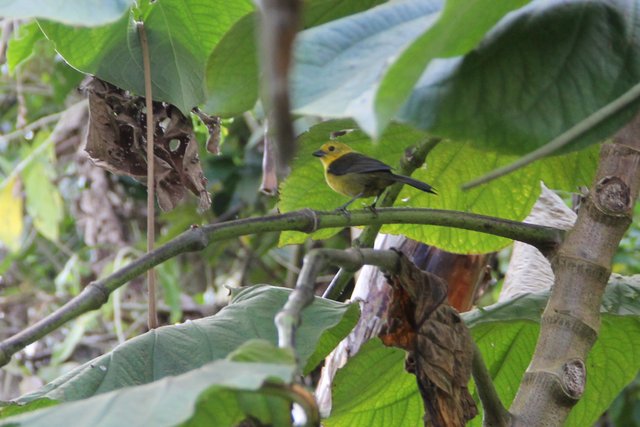
Now we have cleared all doubts about these two species of birds; the Yellow-headed Brushfinch; Atlapetes flaviceps, and the Tolima dove; Leptotila conoveri and we can reaffirm that they are of great convenience in our region.
Pues bien; despejado todas las dudas acerca de éstas dos especies de aves; él Atlapetes de anteojos; Atlapetes flaviceps, y la Caminera Tolimense; Leptotila conoveri, podemos reafirmar que son de gran conveniencia en nuestra región.
First the two species are endemic, which means that it can only be seen in Colombian territory. Second, both the Yellow-headed Brushfinch and the Tolima dove are vulnerable within the national category of threat according to the Red Book of Birds of Colombia. Third, they are also in danger according to the global categorization of the International Union for the Conservation of Nature (IUCN) .
Primero las dos especies son endémicas; quiere decir que sólo se puede ver en territorio colombiano. Segundo tanto el Atlapetes de anteojos y la Caminera Tolimense, son vulnerables; dentro de la categoría nacional de amenaza según el Libro Rojo de Aves de Colombia. Tercero también están en peligro de acuerdo con la categorización global de la Unión Internacional para la Conservación de la Naturaleza (UICN).
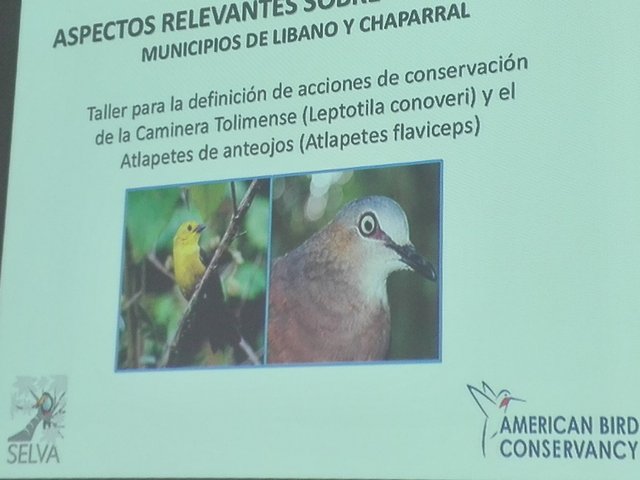
Frankly the removal of our concerns about these two species was thanks to the valuable information provided at the Forum "Workshop for the definition of conservation of the Tolima dove (Leptotila conoveri) and the Yellow-headed Brushfinch (Atlapetes flaviceps)", carried out by the Foundation SELVA and the AMERICAN BIRD CONSERVANCY (ABC), the second of February of the present year 2019, in the city of Ibagué, capital of the department of Tolima, in the South American country of Colombia.
Francamente el despeje de nuestras inquietudes sobre éstas dos especies fue gracias a la valiosa información suministrada en el Foro “Taller para la definición de conservación de la Caminera Tolimense (Leptotila conoveri) y el Atlapetes de anteojos (Atlapetes flaviceps)”, realizado por la Fundación SELVA y la AMERICAN BIRD CONSERVANCY (ABC), el pasado dos (2) de febrero del presente año 2019, en la ciudad de Ibagué, capital del departamento del Tolima, en Colombia sur América.
We should highlight and thank the American Bird Conservancy, who identified that these two species of birds were vulnerable and endangered according to the aforementioned categories and that there were no environmental entities or people working on it.
Hay que resaltar y agradecer a la American Bird Conservancy, quienes identificaron que éstas dos especies de aves estaban vulnerables y en peligro de acuerdo a las categorías antes mencionadas y que no habían entidades ambientales ni personas trabajando en ello.
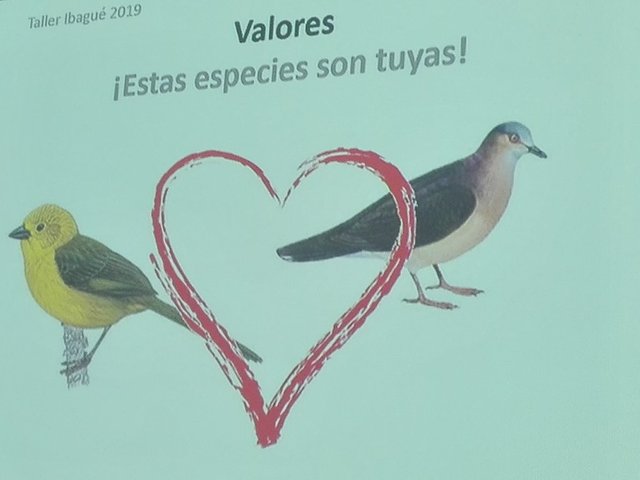
In an interview with Wendy Willis, deputy director of ABC's international division, she shared the following: "The goal and priority is to secure five hundred (500) individuals of each species that are critically endangered or in danger according to the International Union for Conservation of Nature (IUCN), and to insure that these bird species are in a conservation plan”. She also told us that part of the process is to identify "which species of birds are in danger; (EN) and are not being protected or are not in a conservation plan", according to the research, "nobody was doing anything to help these two species."
En entrevista con Wendy Willis, subdirectora de la división internacional de la ABC, nos compartió lo siguiente: “la meta y la prioridad es asegurar quinientos (500) individuos de cada especie que se encuentra críticamente amenazadas o en peligro de acuerdo con la International Union for Conservation of Nature (IUCN), y que éstas especies de aves estén en un plan de conservación. También nos contó que parte del proceso es identificar “cuáles especies de aves están en peligro; (EN) y no están siendo protegidas o no se encuentran en un plan de conservación” de acuerdo a la investigación “nadie estaba haciendo nada para ayudar a las dos especies”.
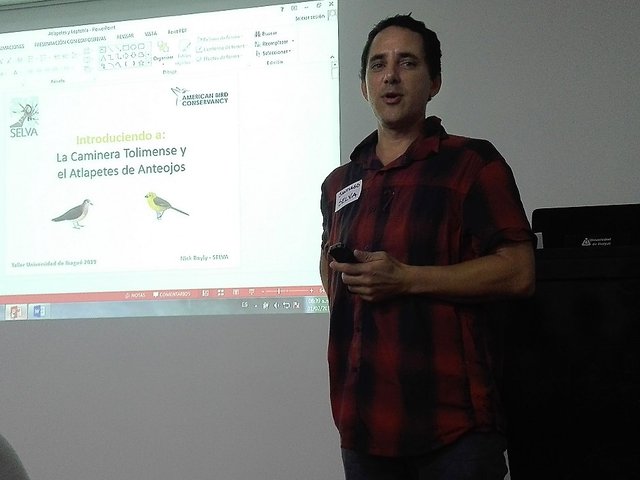
This is how the ABC contacted the SELVA Foundation, with whom they had already developed studies of migratory birds. They undertook the task of starting a new study that took them two years (2017-2018), because the information on these two species was non existant, they did not know their real threats nor their areas of greater distribution nor their population density.
Fue así como la ABC contactó a la Fundación SELVA, con quienes ya habían desarrollado estudios de aves migratorias. Se dieron a la tarea de iniciar todo un nuevo estudio que les tomó dos años (2017-2018), pues la información sobre éstas dos especies era nula e insuficiente, no sabían las reales amenazas ni sus áreas de mayor distribución ni tampoco su densidad poblacional.
Learning with SELVA scientists: Conservation Research in the Neo-Tropics
Aprendiendo con los científicos de SELVA: Investigación para la Conservación en el Neo trópico
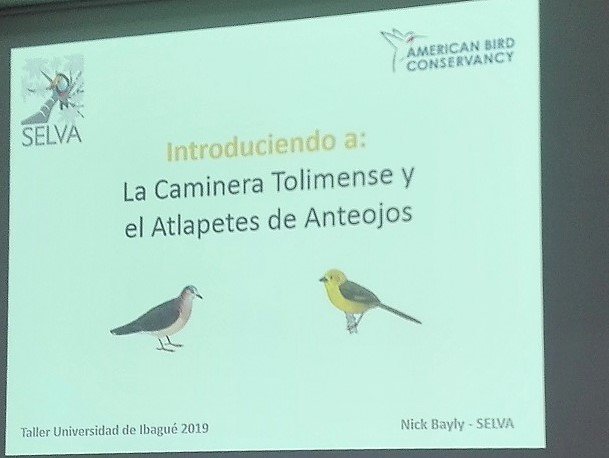
When SELVA started the Forum-Workshop, it did so with a very intriguing title, "Introducing the Tolima dove and the Yellow-headed Brushfinch", as if they had just discovered new species. From the first moment I was surprised by the dedication of the scientists, especially foreigners who come from far away to contribute to the conservation of nature, motivation and education of the locals.
Cuando SELVA dio inicio al Foro-Taller lo hizo con un titulo muy impactante, “Introduciendo a La Caminera Tolimense y al Atlapetes de anteojos”. Desde el primer momento me sorprendió la pertenencia que tienen los científicos, en especial los extranjeros que vienen desde muy lejos a contribuir con la conservación de la naturaleza, la motivación y la educación de los locales.
Highlighting some of the most important points about the Atlapetes flaviceps; I can communicate the following. The Atlapetes flaviceps, being an endemic bird, is only found between the central and western Andes of Colombia and not anywhere else on the planet. Our brushfinch occupies a 'reduced' area in a 'restricted' elevation range between 1,550 meters and 2,700 meters above sea level. It visits the low strata and bushes that are found on the edges of the forest in the departments of Tolima, Huila, Valle del Cauca, Caldas and Antioquia and, according to the study, its estimated that they are not more than 10,000 individuals in the distribution area, which has an extension of 6,880 Km 2(1). The study also showed that the municipalities with the greatest abundance of this species are Roncesvalles, Ibagué and Planadas; these three municipalities are part of the department of Tolima.
Resaltando algunos de los puntos más importantes sobre el Atlapetes flaviceps; puedo comunicarles lo siguiente. El Atlapetes flaviceps, siendo una especie de ave endémica, solo se encuentra entre la cordillera central y occidental de los Andes y no en ningún otro lugar del planeta. Nuestro gorrión ocupa un área ‘reducida’ en un rango de elevación ‘restringido’ entre los 1.550 metros a los 2.700 metros sobre el nivel del mar. Visita los estratos bajos y los matorrales que se encuentran en los bordes del bosque en los departamentos del Tolima, Huila, Valle del Cauca, Caldas y Antioquia y según el estudio estimaron que no registran más de los 10.0000 individuos en el área de distribución, que tiene una extensión de 6.880 Km2(1). También el estudio arrojó que los municipios de mayor abundancia de la especie son Roncesvalles, Ibagué y Planadas; éstas tres municipalidades hacen parte del departamento del Tolima.
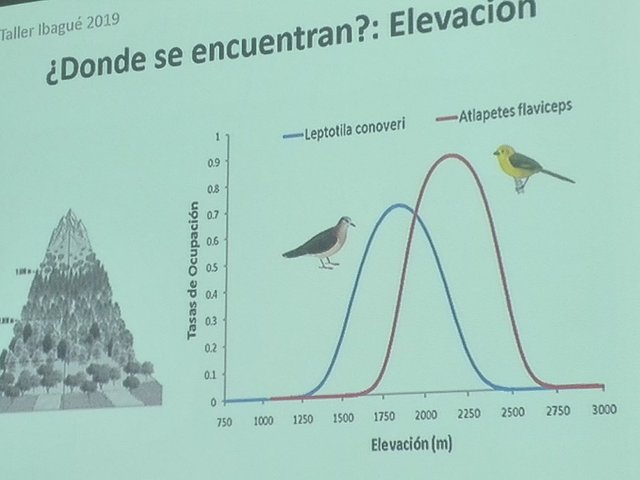
The threats reflected in the study indicate that human action is at the forefront of the destruction of habitats due to the extension of the agricultural frontier, bad agricultural practices, misinformation, ignorance about the importance of endemic species, and forest loss, among other reasons.
Las amenazas reflejadas en el estudio indican que la acción humana prima en la destrucción de hábitats por extensión de la frontera agrícola, las malas prácticas agrícolas, la desinformación, el desconocimiento sobre la importancia de las especies endémicas, y la perdida de bosque, entre otras razones.
According to the study, I can tell you that the Tolima dove Leptotila conoveri is present in the departments of Tolima, Huila, Cundinamarca, and Valle del Cauca. The most recent documented populations are also on the eastern slope of the central mountain range in the Department of Tolima; the species is distributed between 1,250 and 2,050 meters above sea level and is distributed within an area of less than 5,025 km 2 . One fact that left me very happy is that they found three places in the department of Tolima with a significant population of this species: Chaparral, Ibagué and my municipality of El Líbano.
Según el estudio, les puedo contar que la Caminera Tolimense Leptotila conoveri hace presencia en los departamentos de Tolima, Huila, Cundinamarca, y Valle del Cauca. También las poblaciones más recientes documentadas están en la vertiente oriental de la cordillera central en el Departamento del Tolima; la especie se distribuye entre los 1.250 a los 2.050 metros sobre el nivel del mar y se distribuye en una extensión menos de 5.025 Km2. Un dato que me dejó muy feliz es que encontraron tres lugares en el departamento del Tolima: Chaparral, Ibagué y mi municipio El Líbano donde se encuentra más población de ésta especie.
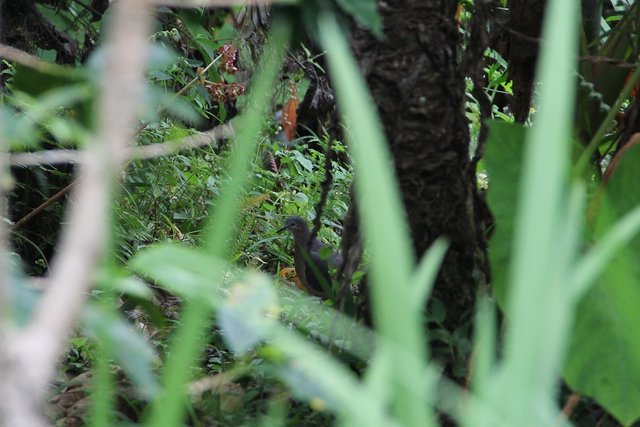
Because the distribution area of the Tolima dove is in a strip of the Andes where there is greater agricultural and urban development, this species faces loss of:
Debido a que el área de distribución de la Caminera Tolimense esta en la franja de los Andes donde hay mayor desarrollo agrícola y urbano, ésta especie se enfrenta con perdida de:
- wooded areas
- secondary forests
- native shrubby vegetation
- áreas boscosas
- bosques secundarios
- vegetación arbustiva nativa
And threats from:
Y amenazas por:
- absence of protected areas
- hunting
- expansion of territory for cattle grazing.
- the lack of education about the species and its conservation needs
- ausencia de áreas protegidas
- la cacería
- la expansión de las actividades ganaderas
- la falta de educación para conocer de la especie y sus necesidades de conservación
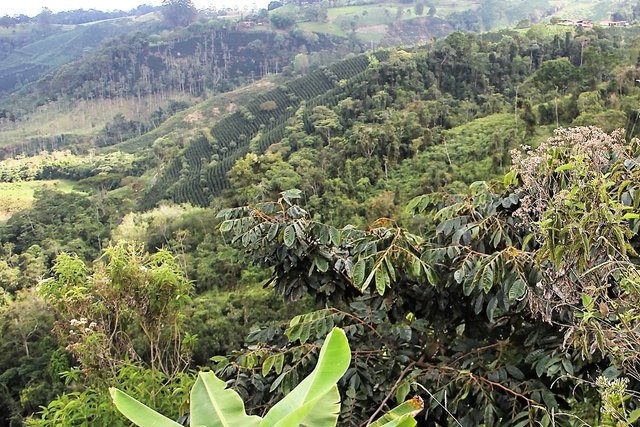
Bearing in mind that these two species of endemic birds have small distributions and very restricted elevations, it is obvious that these endemic species need a strategic plan to ensure their permanence. Additionally, the areas where they live and feed are in areas with the greatest land use change by humans, in terms of area reduction for the survival of these birds.
Teniendo en cuenta que éstas dos especies de aves endémicas presentan distribuciones reducidas y elevaciones muy restringidas es obvio que éstas especies endémicas necesitan un plan estratégico para asegurar su permanencia. Añadiendo que las áreas donde habitan y se alimenta están dentro de los lugares de mayor cambio del paisaje por acción humana en términos de reducción de área para la supervivencia de éstas especies.
With love and empowerment I invite you to be part of the conservation plan of these two species of birds. I will tell you more details in part two of this series, which will include the objectives for the conservation of the Yellow-headed Brushfinch; Atlapetes flaviceps, and the Tolima dove; Leptotila conoveri.
Con amor y empoderamiento los invito a ser parte del plan de conservación de éstas dos especies de aves. Les contaré con detalle en la parte dos de éste artículo, que incluirá los objetivos para la conservación del Atlapetes de anteojos; Atlapetes flaviceps, y la Caminera Tolimense; Leptotila conoveri.
God bless you
Dios los bendiga
Bibliografía/References:
(1)Escudero-Páez, S. P., Botero-Delgadillo, E., Moreno, M.I., Caicedo, P., Sanabria, J. y Bayly, N.J. 2018. Identificando áreas prioritarias para la conservación del Atlapetes de Anteojos y La Paloma Caminera Tolimense en Colombia. Informe Final presentado a American Bird Conservancy. SELVA: Investigación para la Conservación en el Neotrópico, Bogotá D.C. 69 pp.
Ayerbe -Quiñones Fernando. 2018. Guía ilustrada de la Avifauna colombiana.
This post is sponsored and featured by @Appreciator in collaboration with @c-squared. Just keep up the good work.
This post was shared in the Curation Collective Discord community for curators, and upvoted and resteemed by the @c-squared community account after manual review.
@c-squared runs a community witness. Please consider using one of your witness votes on us here
Congratulations @ecoinstante! You have completed the following achievement on the Steem blockchain and have been rewarded with new badge(s) :
You can view your badges on your Steem Board and compare to others on the Steem Ranking
If you no longer want to receive notifications, reply to this comment with the word
STOPDo not miss the last post from @steemitboard:
Vote for @Steemitboard as a witness to get one more award and increased upvotes!